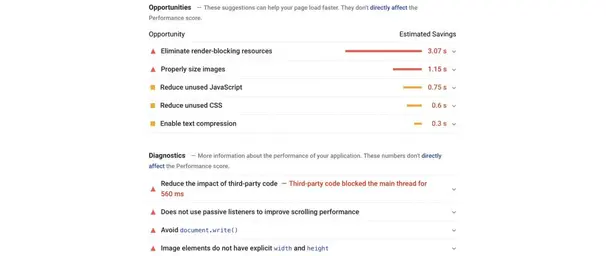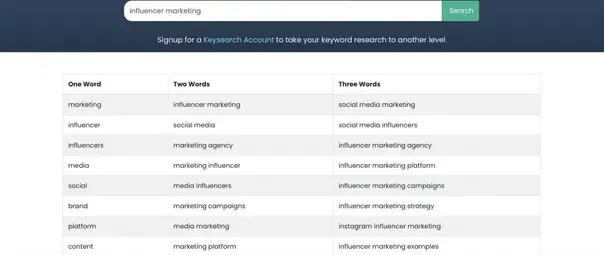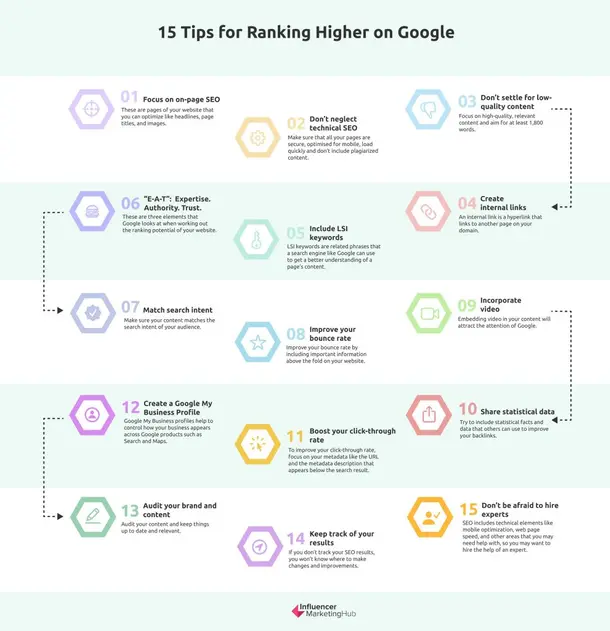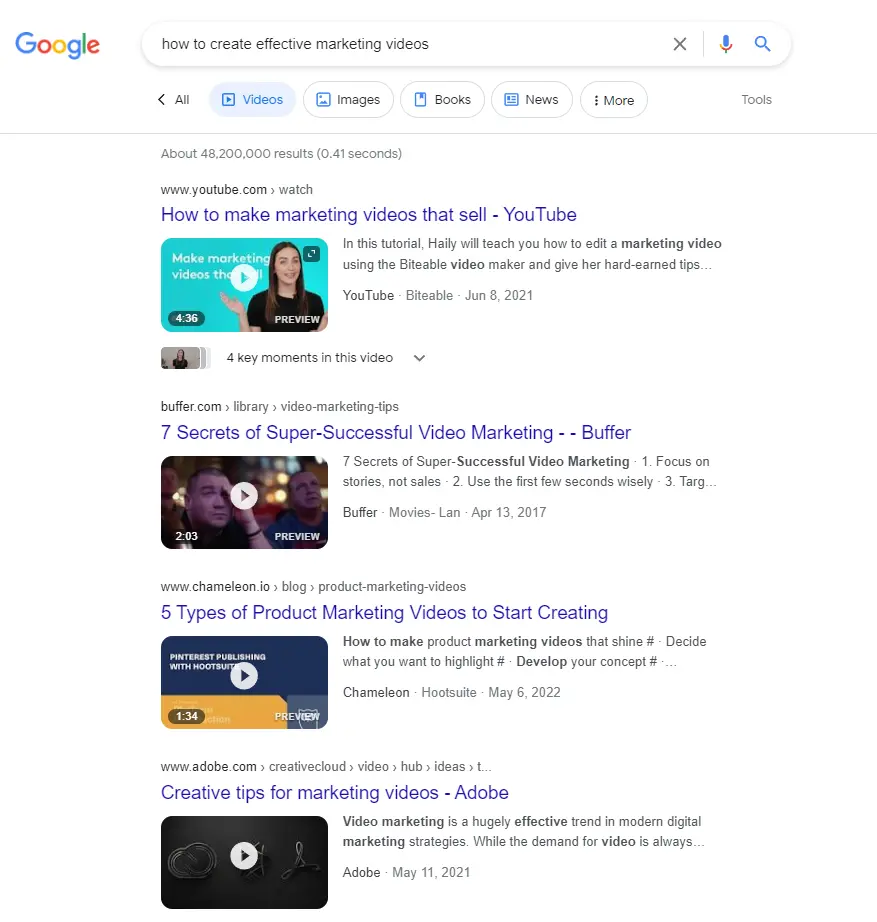Brands and their marketing teams have loads of things they need to count nowadays. They need to count their number of likes, followers, retweets, comments, shares, tags, mentions, etc. Plus, if you’re still in business – especially after the COVID-19 pandemic – you should also remember to count your blessings.
With more than 37 social media platforms available at your disposal just for marketing, it can be difficult to make time to keep track of your Google ranking on top of that. After all, haven’t social networks changed how people search for information? Have we perhaps reached that stage where these channels can replace Google?
According to data shared by Semrush, Google is still the most popular website worldwide, receiving over 131 billion total monthly visits. To put this in perspective, YouTube gets 71 billion total monthly visits, while Instagram attracts just over 6 billion. In fact, Google has held the top spot as the most popular website for the past decade.
So, yes, in 2024, you should still care about how you rank on Google.
Yet, even though Google has been such a powerful force in our lives for the last 10+ years at least, ranking high on Google is still one of the biggest challenges. Firstly, it’s competitive. Secondly, you need to figure out how Google’s algorithm works.
To help you crack the code for how you can rank higher on Google, we’ve summarized 15 best practices. Some of these you might already be implementing; other tips might be new to you. Whatever the case, go over each of these and take stock of where you can make changes in the new year.
Why Does Your Google Ranking Still Matter?
Even though the digital marketing landscape has exploded with new platforms growing in popularity, a high ranking on Google remains one of the best ways to boost traffic to your website. According to online data, the first five organic results on the first page generate more than 67% of all clicks!
Ultimately, if more people visit your website, you have more opportunity to turn these visitors into new customers. Also, if you rank higher than your competitors, you can steal some of their potential customers.
However, it’s not just about winning new customers (or diverting some of your competitors’ potential customers). It also helps to boost the credibility of your brand or business. While credibility might sound more boring than new customers, if you can convince your target audience that you’re one of the most credible sources in your niche, it will, at the end, also help to turn leads into paying customers.
15 Tips for Ranking Higher
1. Focus on on-page SEO
In 2024, on-page optimization remains one of the easiest ways to boost your rankings on Google. Not only doesn’t it take a lot of time to do, but you’ll also see results quickly. In short, it refers to all the elements that appear on the pages of your website that you can optimize like headlines, page titles, and images. On the other hand, off-page SEO (which is just as important) has to do with creating relevance for search engines by, for example, getting more backlinks (a key topic that we’ll focus on in more detail later in this article).
Here are some best practices to help you with on-site SEO:
- Use your keywords at the beginning of your title tags
- Focus on creating long-form content (aim for at least 1,800 words)
- Insert your keyword two to three times per page (keyword stuffing will get you the opposite result)
2. Don’t neglect technical SEO
In short, technical SEO refers to making sure that your website is designed in such a way that search engines will be able to crawl and index it easily. Content is still king, but if the search engines can’t find, crawl, and index your pages, all your efforts will be in vain.
For example, you’ll need to make sure that:
- All your pages are secure
- Your site is optimized for mobile
- You don’t have any plagiarized content or similar content on different pages of your own site
- Pages load quickly
- All the links work
Security
Google gives preference to websites that have HTTPS (short for hypertext transfer protocol secure). Basically, it helps to make sure that any information that gets sent between the website and user is secured.
If for some strange reason you don’t have HTTPS yet, make it a priority to get an SSL certificate in 2024 to authenticate the identity of your website. After all, it shouldn’t be just about appeasing the search engines, but also about keeping your users safe. The fact that Google will reward you for this extra measure is merely a nice gesture.
Speed
Not only will pages that load faster lower your bounce rate, but Google’s algorithm also uses it as a factor when ranking websites. While many of the other elements are relatively easy DIY projects, if you don’t have loads of technical skills, you’ll probably need an SEO or website design agency to help you with this step.
Alternatively, Google’s PageSpeed tools can be useful. It will analyze the content on your pages, give you insight into your “Speed Index” score and then make recommendations for how you can boost loading times.

Source: pagespeed.web.dev
User experience (UX)
It should be easy for users and search engines to find their way around your site. Not only should your pages be straightforward to navigate, but it should also look professional and attractive.
Mobile optimization
While all these elements are important, it’s crucial that your site is optimized for mobile devices. No visitor should have to zoom in to be able to read content via a mobile device or struggle to click on a button. Definitely not in 2024!
If you’re still not convinced that it’s that big of a deal, consider this:
More traffic gets generated via mobile devices than desktop. Also, Google mainly uses the mobile version of a website for ranking and indexing.
While the actual website design and layout on mobile can be different to optimize the user experience, the content must still be the same as the desktop site. So, if you thought it’s as straightforward as deleting some sections of text, it’s not. Just like you’ll likely need the help of pros to improve your page speed, mobile optimization is also best entrusted to website design agencies that focus on technical SEO.
3. Don’t settle for low-quality content (ever)
Backlinks (links posted on a third-party website that link back to your website) play a massive role in Google’s algorithm. So, one of your main goals should be to get visitors to share your posts on social media. And, you can only expect visitors to do that if you post high-quality content regularly.
Not only do backlinks show that users find your content useful, but it also helps to show to others that you’re knowledgeable about your niche. And, the more people who link to your content, the more it’s telling Google that your content is credible and shareable.
However, you shouldn’t just create content, sit back, and wait for others to share it. Instead, you should actively try to pursue it by contacting other authoritative websites and brands and asking them if they would be interested in publishing a guest post that you’ve written. This way, you can add your own backlinks to relevant content on your website. Plus, if you get authoritative websites to link back to your website, it can boost your domain authority (DA) score. Once again, this strategy will only work if you create high-quality content. This means that you should guard against coming across as too spammy, something which is a common trap of writing guest posts.
All in all, nowadays the focus is more on high-quality, relevant content than the number of keywords a page has. Earlier we mentioned that you should at least aim for 1,800 words, but posts that are longer than 3,000 words work even better for creating links. After all, it’s not really the individual keywords that keep readers hooked to your page, but the overall quality of your content. In other words, writing that’s relevant, engaging, and well-written is your best bet to the top.
4. Create internal links
While we’ve written a lot about the importance of backlinks, you should also focus on creating internal links. An internal link is a hyperlink that links to another page on the same domain. In short, they help Google with finding and indexing your web pages.
One of the advantages of using internal links is that the anchor text may match the content exactly. So, they’re pretty straightforward to create and you don’t have to rely on other third-party websites. Ideally, you should place the internal links toward the beginning of the web page. This can also help to improve your bounce rate (and by improve we mean lower, but more about this later).
5. Include LSI keywords
LSI keywords (aka latent semantic indexing) refers to related phrases that a search engine like Google can use to get a better understanding of a page’s content. However, they’re not entirely synonyms, but rather phrases and words that are closely connected to your main keyword.
For example, if your main keyword is influencer marketing, LSI keywords can be words and phrases like social media, marketing campaigns, brands, Instagram, marketers, endorsements, etc. You get the idea.

Source: keysearch.co
Sure, you can still use synonyms, but you’ll need to use LSI keywords too. The reason for this is that search engines evolved over time. Nowadays, you no longer need to be guilty of keyword density just so that Google will grasp what your page is all about.
As a matter of fact, it’s no longer good enough only to optimize your content for a handful of keywords. Instead, Google wants to find out what your page is about in general. So, it will use these types of keywords to verify that your content is, in fact, about the topic.
Plus, using LSI keywords also helps to improve your topical depth which in return helps with relevancy. In 2024, topical depth will become more important (hence, the preference for long-form content). So, be sure to build and expand your content around other related keywords and subtopics as well.
After all, as there are free online tools that will do this research for you, you have no excuse not to put in the “extra effort”. You can, for example, check out a tool like LSIGraph or KeySearch to identify relevant LSI keywords.
6. “E-A-T” more
While SEO is one of the main buzzwords whenever Google rankings are discussed, Google E-A-T is another three-letter acronym that can help you in the new year. Basically, it stands for expertise, authority, and trust. These are three elements that Google looks at when working out the ranking potential of your website. It’s even more important if your website focuses on so-called YMYL topics (aka your money or your life). These typically include content that offers medical, legal, safety, or financial information.
Expertise refers to the credibility and experience of your author(s). When visitors land on your website, will they find content written by authors who are trustworthy and experienced? To show your expertise, you can, for example, include short author bios on your website, like yours truly has done.
Authoritativeness basically has to do with your online rep and the recognition that you’re getting. That’s another reason why it’s important to get authoritative sources to link back to your content. For example, a press release can be valuable if you want to get mentions from the right type of press (in terms of SEO, there’s something like bad publicity).
Trustworthiness has a lot to do with the other two elements. If you’ve demonstrated that you’re qualified to write about your topic and other sources turn to you for the value that you offer, Google will view you as trustworthy.
A lot of the other strategies discussed in this blog post can ultimately help you to improve your E-A-T score. For example, high-quality articles will help to demonstrate your expertise in your niche and establish your business as an authoritative figure, while site security can help to build trust further.
7. Match search intent
Do you know what your target audience actually wants to know about the topics that you plan to write about? You might think that they already know all the basics about a topic like influencer marketing and want to know all the in-depth details or vice versa.
Basically, Google rewards the websites that share content that people are searching for most often. What does your target audience typically enter into Google’s search bar? Do they turn to the internet for how-to guides, real-life examples or tips for beginners?
One way to make sure that your content matches search intent is to look at the content that ranks on the first page. Do your articles cover that content? If not, see it as an opportunity to repurpose some of your older content so that it’s more in line with what your target audience is currently searching for online.
8. Improve your bounce rate
If visitors land on your site, look at one of your pages and return back to the search page in a matter of seconds, it will hurt your search rankings. To Google, this is an indication that users aren’t impressed with your website. In other words, a lower bounce rate shows that users actually enjoy browsing your site.
Not only is a low bounce rate better for search ranking, but it will also mean that visitors have more time to get better acquainted with your brand which can help to increase sales and customer loyalty. After all, isn’t this your real goal at the end of the day?
To improve your bounce rate, make sure that all the most important info appears above the fold (in other words, visitors shouldn’t have to scroll down to find the information that they need). Adding a table of contents (or a summary like we do) can also help visitors to go directly to the section that’s relevant to their query. And, to make your content easier to digest, it’s key that you add visual elements like infographics and videos, which brings us to our next SEO strategy.
9. Incorporate video
A lot has been written about content and keywords. Most of the time, this is immediately associated with written content like blog posts, white papers, state of the industry reports, etc. However, content can (and should) also be in the form of video.
In fact, nowadays, you’re more likely to see videos pop up in the form of video carousels in the search results than in the past. Remember, Google offers not only text results, but also video, images, and news articles to help create a better user experience.
In addition to embedding videos on your web pages, it can also help to create your own YouTube channel where you upload these videos. Not only will it attract the attention of Google, but it can also keep visitors on your site for longer which also helps to signal to the search engines that your website matches search intent.
10. Share statistical data
From time to time, you can also try to include content, like facts and figures, that others can quote on their own blogs. Content creators often link back to statistics which can earn you valuable backlinks.
You can, for example, add it in the form of an infographic. As mentioned earlier, adding visuals like infographics can also help to lower your bounce rate which in return will also improve Google search page rankings.
If you regularly read our blog, you would know that we love to publish stats. As Exhibit A (aka the screenshot below) shows, it has helped us to create numerous backlinks (and from authoritative sources, if we may boast a bit).
11. Boost your click-through rate
While rankings are important, you should also keep an eye on organic traffic. After all, what’s the use that your target audience stumbled upon your site via an online search, but didn’t actually visit your website? This is why monitoring your click-through rate is crucial.
To improve your click-through rate, focus on your metadata like the URL and the metadata description that appears below the search result. It might sound insignificant, but if this info looks relevant and credible, your click-through rate will benefit which in return will boost your ranking too.
All things considered, shorter, yet descriptive URLs, work better. With regards to your title tags, don’t be scared to appeal to your readers’ emotions. This is one of your few chances that you get to convince users to click on your link.
12. Create a Google My Business Profile
Businesses can also get a better Google ranking for local searches by creating a Google My Business profile. In short, a Google My Business profile helps you to control how your business appears across Google products such as Search and Maps.
So, double-check that all your business details, like contact details, business hours, and address, are correct and complete. According to Google’s help page, relevance and prominence play a key role.
If your Google My Business profile closely links to what your target audience typically searches for, Google will find it easier to match your profile to the right searches. Also, if your business has more Google reviews, it can help to boost your local ranking on Google.
To help you with this process, there are a number of Google My Business scheduling tools and platforms that you can try out. You can, for example, check out Loomly, ContentCal, Sendible, and Social Pilot. Not only will they help you with Google My Business specifically, but most of these also integrate with other useful social platforms.
13. Audit your brand and content
Your overall branding can also impact your ranking. As mentioned, your Google E-A-T score essentially takes into account if your brand can be trusted. Do you come across as an expert in your field? While the quality of your content will play a huge role, it will be of less help if your branding isn’t applied consistently.
Also, while a lot of the focus is on creating more content, don’t forget to audit your existing content. If your current level of expertise or standards has outgrown an older post, it’s better to remove it. Perhaps your target audience’s needs have changed? Whatever the case, don’t keep content on your site because you think quantity will make you look better. Just like many things in life, quantity shouldn’t replace quality.
14. Keep track of your results
Not only should you audit your brand and content regularly, but it’s also key that you monitor your SEO results. While it won’t improve your SEO directly (Google won’t know about this step), if you don’t know how much organic traffic you’re getting, what’s the point? This also helps you to double-check that you are, in fact, ranking for all the keywords that you’re targeting.
Also, does the traffic boost convert to more customers and sales? SEO is time-consuming and if you don’t track your results, you won’t know where to make changes and if it’s worth the time and effort.
15. Don’t be afraid to hire experts
While there are more technical elements like mobile optimization and web page speed that you’ll be more inclined to leave to the professionals, it doesn’t mean that everything else you should do on your own. Whether you need a freelance content writer or a UX designer, if there’s any other aspect that you feel you need help with, hire the help of the professionals. We’re talking about your online presence here. That’s a lot that’s at stake.
Wrapping Things Up
If you’ve dreaded SEO in the past, don’t drag old fears along with you into the new year. Sure, we’ve shared a long list of things to do and change, but as you’ve probably picked up many of these are linked.
For example, high-quality content leads to more backlinks which boost your credibility. Improving your page speed can also lower your bounce rate which shows to Google that people are trusting your site. You get the idea.
So, while it might sound like too much work, in actual fact, if you’re working on one aspect, you’re also busy improving a number of other elements. And, if you don’t know where to start, your content is a pretty good place. After all, all clicks lead back to your content.
Frequently Asked Questions
What’s on-page SEO and how can you improve it?
In short, on-page SEO refers to all the elements, such as headlines, page titles, and images, that appear on the pages of your website that you can optimize. To improve on-page SEO, try to create longer form content of at least 1,800 words. With regards to keywords, try to use your keywords at the beginning of your title tags and insert your keyword two to three times per page. All in all, on-page optimization is one of the easiest ways to boost your rankings.
How can you help search engines to crawl and index your website?
To make sure that your website is designed in a way that search engines will be able to crawl and index it easily, you’ll need to focus on page speed, creating internal links, and optimizing it for mobile. Also, when you create internal links, make sure that all the links actually work. Other ways that you can improve technical SEO is to make sure your website is secure and that you’ve used only unique content (so remove any content that’s too similar to content published elsewhere).
Are backlinks important for SEO?
Yes, backlinks are critical if you want to rank higher. Links posted on a third-party website that link back to your website show that users find your content useful. It also helps to show to others that you’re knowledgeable about your niche. What’s more, if you get authoritative websites to link back to your website, it can boost your domain authority (DA) score. All in all, backlinks are critical to help prove to Google your expertise, authoritativeness, and trustworthiness which in return will boost your ranking.
Can internal links help you to rank higher on Google?
An internal link is a hyperlink that links to another page on the same domain and it can help Google with finding and indexing your web pages. Internal links are very easy to create and, unlike backlinks, you don’t have to wait for other third-party websites to link back to your content. Ideally, you should place the internal links toward the beginning of the web page. This can also help to improve your bounce rate which is also good for search result rankings.
How can you lower your bounce rate?
To improve your bounce rate (in other words lower it), make sure that all the most important information appears above the fold. Website visitors shouldn’t have to scroll down to find the information that they need. You can also add a table of contents to your blog posts so that visitors can go directly to the section that’s relevant to their query. Plus, to make your content overall easier to read, it’s important that you add visual elements like photos, videos, and infographics.










